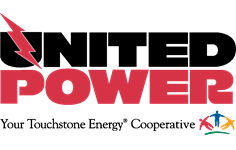Inverter-Based Generation Facility No Larger than 25 kW
Through an interconnection agreement, United Power members can connect their independently-owned renewable energy generation systems or battery storage systems directly to the cooperative's distribution system. At this time, United Power does not offer a rebate for new system installations.
To interconnect to the distribution system a member must complete the corresponding application and follow all requirements associated with that system. In addition, members will be required to sign the United Power Interconnection Terms and Conditions.
Qualifying Generation Facilities
For more information about the process to connect a Qualifying Generation Facility to the cooperative distribution system, please click here.
Net Metering Interconnection
Net-metering allows a member to offset their electric usage through on-site generation of electricity through solar, wind, biomass, etc. In essence, net-metering allows a meter to spin forward when the member is a net user of energy or backwards when the member is a net generator of electricity. At the end of the month, a net-zero home would have spun the meter backwards as much as it was spun forward, essentially metering zero energy usage.
Please review United Power's Solar Interconnection Standards and Terms & Conditions before signing a contract with a solar installer. If you are ready to install, review and submit our online application with your solar contractor.
Net Metering Policy Summary
- System generation can not exceed 200% of the annual usage at that location.
- On a monthly basis, excess kwh’s will be rolled over to the next month for future use at the member’s applicable rate. A member’s minimum bill will be the associated fixed service & facility charge for that member’s rate.
- On an annual basis (expressed in an Apr – Mar period), a member that continues to have excess generation will be cashed out at the wholesale energy rate.
Important: Any projected value of the electricity produced by these systems is not guaranteed by the utility. Changes in rates, rate structures or net-metering policy could affect this value and existing practices will not be grandfathered
Are You a DIY Power Generator?
Systems connected without proper notification to United Power will be immediately disabled, and can result in service being terminated to the member until all requirements are met. Read more about the importance of meeting safety requirements for interconnected systems here.
State law allows you to generate up to 200% of your annual home usage with solar. You can use the resources available below to estimate the amount of solar you can install.
Power Portal
The Power Portal gives members the power to view in-depth energy use data to analyze consumption patterns, mark changes in behavior to monitor effectiveness and export usage data for further analysis.
NREL PVWatts Calculator
The PVWatts calculator may be used to estimate the energy production and cost of energy for grid-connected photovoltaic (PV) energy systems. It allows homeowners, small building owners, installers and manufacturers to easily develop estimates of the performance of potential PV installations. This calculator can be used to identify how many kilowatt hours your solar installation will generate during the year.
Installation Criteria
The following criteria are required for the installation of solar on the United Power grid:
- A one-line engineering drawing (see examples below), typically provided by your solar installer, is required with each solar application.
- The contractor installing your solar panels will be required to place a disconnect switch and production meter housing on the side of your home. These are required for safety and billing purposes.
- Your solar contractor will also need to arrange for an inspection with the local authority having jurisdiction (AHJ) to ensure the solar installation meets local building codes.
- United Power engineers will review solar installations connecting to the grid to ensure the grid can accommodate them.
Battery Storage Interconnection
Although batteries are used for back-up, they can run parallel to the grid and United Power must be aware of the equipment. There are many battery products and services available for you to discuss with your solar installer. These are handled in similar fashion to a new solar installation by reviewing our interconnection Terms & Conditions and submitting an online application.
As a best practice, we recommend reviewing the National Fire Protection Association (NFPA) standard 855 for stationary energy storage with your installation contractor.
Questions to Ask a Solar Contractor
Hiring the right contractor can be a difficult and time consuming process, but it is every bit as important as the product you are purchasing. Due diligence is critical to ensure you get the best system, for a fair price.

